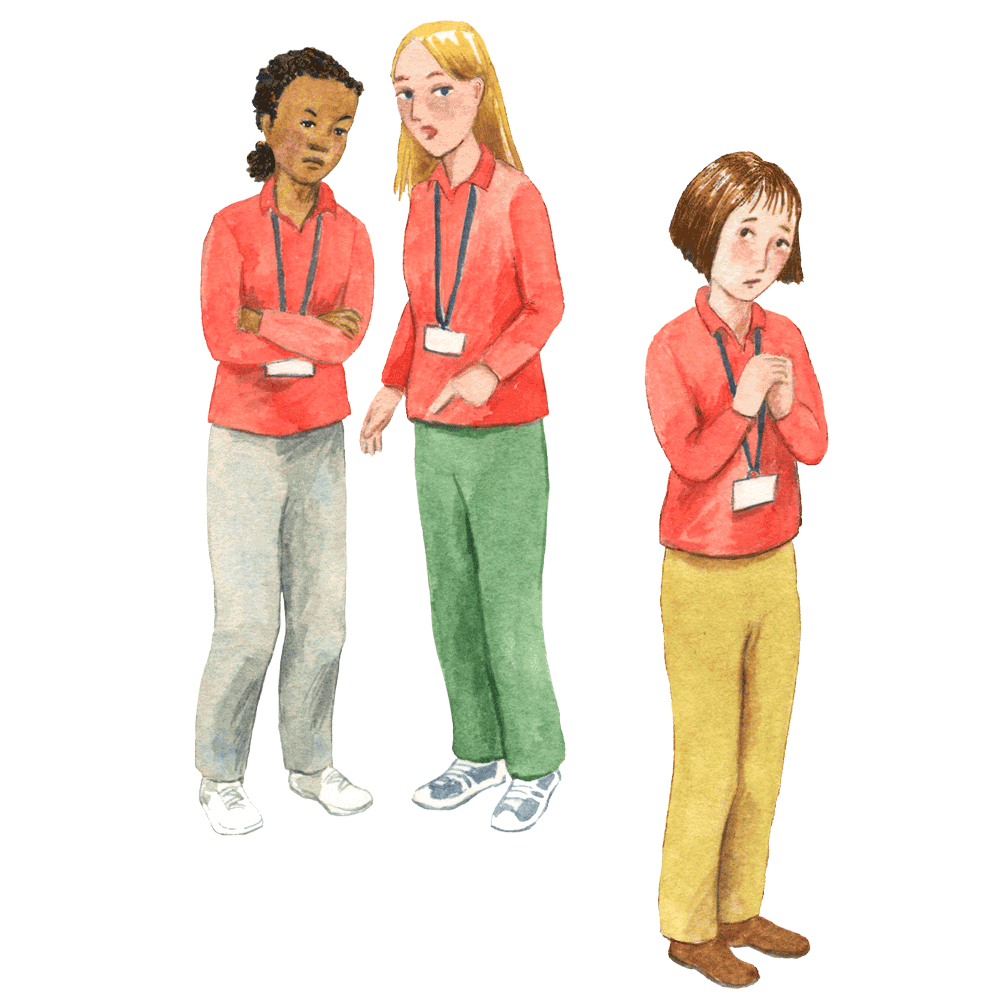
Darkside of Residential Group Homes: Working with Adult Bullies
|
Getting your Trinity Audio player ready...
|
When I look around my fellow treatment counselors, I find two types of people: those who genuinely want to help the kids we work with and those who don’t.
The type of people who choose not to help the kids we work with are usually the ones who have worked there the longest (though not always), ones who walked into the job with a negative prejudgment or developed one overtime, and ones who deep down aren’t there for the right reasons—the children we serve. The real reason they are here is just for the money.
The people who are there for the right reasons will exhibit a few things in common. They are more patient, build rapport with the children, and try to mentor them to the best of their abilities. Although they are not perfect, they are motivated to come to work because deep down they believe what they are doing is of great importance. They are on a mission and wish to help the children they are serving.
The people who are not there for the right reasons also exhibit a few things in common. They lack patience and possess an authoritarian parenting style. In fact, they are adult bullies both to the children and staff they work with. The adult bully is someone who never matured as they progressed through life because, in their youth (or current state of life), they have experienced stress, trauma, low self-esteem, difficult home life, and a lack of higher education. (1)
It breaks my heart because it affects the vulnerable and innocent children who have already been exposed to abuse and neglect in their family homes and removed into foster care. Instead of being protected in the foster care system, the children find themselves exposed to further harm. It’s a tragedy and it’s unacceptable.

The 80/20 Rule
The people who fall into the second category of workers usually make up about 20 percent of the treatment counselors I work with. However, if you ever worked in a residential group home, you will notice that 20 percent of the workers cause 80 percent of the problems or that 80 percent of the work is done by 20 percent of the people.
According to the Pareto principle, also known as the 80/20 rule, inputs and outputs are generally skewed. Wouldn’t you say if 20 percent of the workers cause 80 percent of the problems or that 80 percent of the work is done by 20 percent of the people? So what can we learn from this? A little bit of input can have a big effect on the output.
When you work in a residential group home the amount of reparenting at times feels almost overwhelming. It takes 100 percent team effort. Like the Nigerian proverb says, “It takes a whole village to raise a child.” So, if 20 percent of your team is not highly committed and on top of that creates a negative work environment, then the other 80 percent will be affected. The idea of working as a team falls apart when the input of just 20 percent of its workers creates a greater output of 80 percent.
So what are 80 percent of the problems created by the 20 percent of its workers? Residents were retraumatized and constantly retriggered. And residential treatment counselors were unable to demonstrate healthy and empathic re-parenting techniques, without feeling attacked by their coworkers. I will explain why below.

The result was the Chameleon effect!
When you think about the results, how can a small percentage of team members (only 20 percent) affect 80 percent of the results? Well, this is why! What the 20 percenters were doing was creating an atmosphere where there was conflict and disagreement. An atmosphere where you were walking on eggshells and too afraid to speak up or share honest feelings. People were afraid, kept their heads down, and were okay throwing each other under the bus if it helped them in any way. (2)
Who were the 20 percenters? The authoritarians and adult bullies of the group. Several factors play into the effect of an adult bully. First off, when you are an adult bully your goal is to gain power over another person by making himself or herself the dominant adult. (1) In order for the adult bully to feel powerful or in control, they will try to humiliate their victims, and “show them who’s boss.” (3) Now you can imagine if you are in a group setting how this can play into effect with a group’s psyche.
The tension unconsciously produced the Chameleon effect. Perhaps you’ve heard of this? If you haven’t, the Chameleon effect is the unintentional mimicking or copying of another person’s posture, behaviors, and mannerisms. The staff who tried to build rapport through incentives or rewards to motivate positive behaviors in their children were seen as a threat by the others (that is, the 20 percenters). If the staff were kind to the children, it was like having a target on your back. And if you felt ostracized by the group, you would mould your behavior to match the group that was antagonizing or intimidating you.
How does this relate to the chameleon effect? Just like a chameleon changes its colors to suit its environment, the staff who were there for the right reasons had to do the same thing but with their personalities.
If you knew your coworkers along with your boss were super annoyed by your kindness and retaliated through intimidation and adult bullying, wouldn’t you tone down your kindness to avoid them seeing you as a threat? That’s exactly what I and many other staff did. We toned down our kindness and without even knowing it, we’re slowly being conditioned by the adult bullies of the group. We lost touch with our personal moral beliefs, felt anonymous, and less likely to be caught doing something wrong. And as a group, we felt a diminished sense of personal responsibility for collective actions. (4)
Deep down in my heart, I knew this was wrong. Instead of openly providing incentives or rewards to the residents I worked with, I learned to blend into my environment just like the chameleon. I never openly gave residents incentives or rewards that would trigger the adult bullies. I waited until they weren’t around and then gave with an open heart.

How does this affect the children we work with?
Just like adults, children learn to blend into their environments. We’re all just like the chameleon, learning from the time we are small how to interact with the world and where we fit in it. Environmental variables, such as the surrounding culture, social interactions, and the ongoing trauma a group-home child can face, will condition them to be a byproduct of their environment. As the saying goes, “Monkey see, monkey do.”
Children learn to mimic adults and become conditioned by what they see and hear others do. That’s why kids grow up to copy adults, or in this case, their treatment counselor. And since we are influenced by our social environment, the children we work with will grow up to have similar mannerisms as their caregivers. If their caregiver was an adult bully you can imagine how this can mould and shape a dysfunctional personality.
If a child learns how to treat people from the example of an adult bully, he or she is likely to grow to be a bully as well and may have a hard time developing healthy relationships. (2) The children who grow up in this type of condition believe their situation is hopeless and because they believe that, will continue to be exposed to trauma.
According to the Casey Family study, foster care children are more likely to suffer PTSD at twice the rate of Iraqi war veterans. And yet, our lawmakers, politicians, and policy experts are doing nothing about it. Whose fault is that entirely? No one!
No one is looking at this data about PTSD in the foster care system and thinking, what can we do to change this. I mean, what if your children were diagnosed with PTSD at twice the rate of Iraqi war veterans. Wouldn’t you be concerned and try to get your child the proper care in order to heal from their diagnosis? I mean, where are our lawmakers, politicians, and policy experts’ concerns? Where is the voice looking at this pattern saying, “This is extremely fucked up!”
The problem is that no one’s accountable. No one is looking at the data about congregate care and coming with solutions to investigate and change what is happening behind closed doors. If your child was being treated unfairly, being traumatized, and developing PTSD, wouldn’t you be outraged? Where is the voice looking at this pattern saying, “This is supremely fucked up!” It is!
But me sitting out here, screaming into the wind, does nothing to un-fuck it. It takes a group of individuals who’ve seen it, experienced, and understand to rally together and start speaking up. Would you please join me?
*My assessment of those who are not there for the right reasons comes from my own personal point of contact and personal observations.
Work Cited:
- https://us.ditchthelabel.org/why-do-people-bully/
- https://www.bpdcentral.com/blog/?
- https://www.forbes.com/sites/joefolkman/2016/04/13/are-you-on-the-team-from-hell-5-ways-to-create-a-high-performance-team/#4e37e2937ee2
- https://www.sciencedaily.com/releases/2014/06/140612104950.htm
- https://www.kidsdata.org/topic/4/foster-care/summary